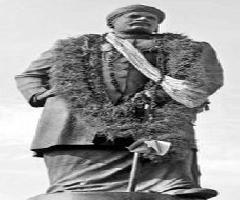

- Category :Wars
Jamrud is a fort about 10 miles off Peshawar. Located at the opening of the Khyber Pass, it formed the outermost limit of the Sikh Empire. It had been captured by the Sikhs under General Hari Singh Nalwa, the Commander-in-Chief of the Sikh Army. The Sikh expansion plans were westwards, as Ranjit Singh the Maharajah of the Sikhs had signed a treaty with the English, which limited his southern border to the river Sutlej. (Treaty of Amritsar 25 April, 1809.)
Expansion Westwards
Jamrud is a fort about 10 miles off Peshawar. Located at the opening of the Khyber Pass, it formed the outermost limit of the Sikh Empire. It had been captured by the Sikhs under General Hari Singh Nalwa, the Commander-in-Chief of the Sikh Army. The Sikh expansion plans were westwards, as Ranjit Singh the Maharajah of the Sikhs had signed a treaty with the English, which limited his southern border to the river Sutlej. (Treaty of Amritsar 25 April, 1809.)
Expansion Westwards
Ranjit Singh had thus perforce to turn his attention towards the West. The significance of this cannot be lost, as in 2000 years of Indian History, this was the first time a Hindu/Sikh force had moved west wards.
All the invasions earlier were from the west.
The Afghan empire in a series of battles with the Sikhs had been steadily losing their territory. Thus Punjab, Multan, Kashmir, Derajat, Hazara and Peshawar which were once part of the kindom of Kabul were lost to the Sikhs. The loss of Peshawar was particularly galling as the inhabitants were fellow Pashtuns and the town was the summer capital of the Afghan Emirs
Towards the end of 1836, Hari Singh Nalwa attacked and captured Jamrud. The frontier of the Sikh Empire now bordered the frontier of Afghanistan. This Sikh victory at Jamrud was followed by the resounding defeat of the Yusafzai chief, Fatteh Khan of Panjtar.
The Siege of Jamrud
In 1837, the Sikh Army was recalled to Lahore to take part in celebrations during the wedding of Kanwar Nau Nihal Singh, who was the grandson of Ranjit Singh. Reports suggest that the Dogras had passed secret information to the Afghans about this. The Afghans were thus encouraged to attack. Accordingly on 23 April 1837, the king of Afghanistan declared a Jihad and besieged Jamrud fort. The Sikhs inside the fort were heavily outnumbered, but they put up a stout resistance against some estimated 20-25000 Afghans. The Afghans also started an artillery bombardment of the fort, but Sikhs held on.
The Message to Hari Singh
The besieged Sikh commanders inside the fort decided that their only hope to escape from their ordeal was to get a message across to Hari Singh in Peshawar. Accordingly a volunteer was sought for this hazardous mission. It is a matter of great pride that a woman, Harsharan kaur, volunteered for this task. She was selected on account of her small size. Harsharan Kaur did the impossible and set course from the fort in the middle of the night. Walking on all fours, she picked her way carefully through the Afghan lines and headed for Peshawar.
The Defeat of the Afghans
Against all odds she successfully reached Peshawar and conveyed the message to Hari Singh. The General though sick, came to the rescue of his beleaguered garrison at Jamrud. Heavy fighting took place and eventually the Afghans were forced to lift the siege and retreat into the Khyber Pass. The Sikhs General Hari Singh however died in the fighting. The Khyber Pass then became the northern boundary of the Sikh empire.
Last Word
The conclusion that one can draw from this battle is that the Afghans were convinced that they did not have the ability to beat the Sikhs. But the death of Hari Singh Nalwa was a serious set back to the Sikh Forward Policy. The battle is famous for the bravery of the Sikhs who repulsed a much larger Afghan force.
References
History of the Sikhs, HD Cunningham, Publisher Oxford University Press
-
Next Post
Top 10 Weird Cultural Phobias
Related Articles
History Of Vaikom Satyagraha
Vaikom Satyagraha has an important place in Kerala history. Read more about Vaikom Satyagraha history, leaders associated and why it was started?.
A Brief History Of Nalanda University
Nalanda was one of the prominent universities in Ancient India. Read a brief history of the institute here..
The History Of Gupta Dynasty
The Gupta Dynasty was one of the most powerful line of kings in ancient India. Read a brief history of the empire here..








